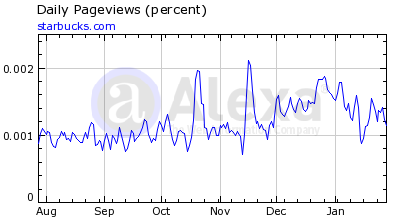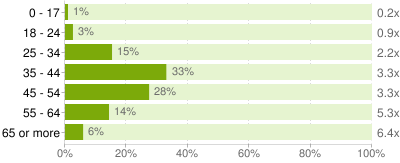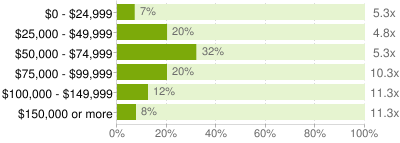The following review is an analysis of Great Cups Coffee Co. (GC3) with Starbucks. The present report provides a detailed analysis of the competitive analysis of Starbucks and GC3 . The first part of the report will deal with the web analytics of Starbucks and show how the competitor is successful or unsuccessful in making its online presence work.
Figure 1 shows that there is a great deal of traffic in the website. Daily page viewers actually provide the percentage of internet users worldwide are viewing Starbucks’ website. The figure shows data for the last 6 months. The data demonstrates that there is a decline in the number of visits to the website and it follows a cyclical pattern.
Visits are more from mid-October to mid-November. The traffic to the website has been high from December through January. However, for the months of August through early October traffic has been low. Web analytics tools show that in the past one month, page views for GC3 have increased by 3% while that of Starbucks has declined by 7.5%. for three months period, GC3 has seen an increase of 180% viewership while Starbucks faced only an increase of 30% viewership.
Figure 1: Website Traffic for Starbucks.

Figure 2: Page views for GC3.
Figure 3: Top Queries from Search Traffic at GC3 and Starbucks.
On comparing, the search queries for the GC3 and Starbucks are provided in figure 3. The table demonstrates that the top searches related for Starbucks is the brand itself while that for GC3 is Keurig. GC3 seem to have to favourite search items are Keurig and K-cups.
A comparative analysis of Starbucks and GC3 based on demographics of viewers and the analysis shows that the age of the viewers to GC3 are less compared to the total number of 18-24 year olds on the Internet. On the other hand, the number of 18-24 year olds is just marginally low for Starbucks. Most of the people surfing GC3 website belongs to the age group of 35 to 64 years while that for Starbucks is 25 to 34 years.
In terms of education, the viewers of Starbucks page are usually been to College while for GC3 the viewers did not attend college or have been to some college. Mostly females surf the Starbucks website while that for GC3 cannot be specifically stated. GC3 is surfed by viewers who mostly have children while Starbucks website is surfed by those who do not have children. GC3 website is surfed mostly from home while Starbucks website from work.
There is a distinct difference in the income group of the viewers visiting GC3 and Starbucks. The former has viewers who mostly belong to the income group of $30,000 to $60,000 and above $100,000. While that for Starbucks is $60,000 to $100,000 and above $100,000. This difference indicates that mostly people with high-income groups surf the Starbucks website.
In both the websites, the maximum viewers are Caucasians. Further, in terms of geographic coverage, Starbucks is viewed in 10 countries including Asian and European countries while that of GC3 is viewed only in the United States. This can be viewed from the data derived from Google Analytics data as shown in figure 4, 5, 6, and 7.
Figure 4: Age Demographics Starbucks visitors.

Figure 5 Income Demographics Starbucks visitors.

Figure 6: Gender Demographics Starbucks visitors.

Figure 7: Education Demographics Starbucks visitors.

Figure 8: Visitors interest in Starbucks website.
Figure 8 shows that the visitors the main interest areas shown by visitors on the website content. Mostly the viewers viewed information of coffee and tea, non-alcoholic beverage and loyalty card programs. From this it can be observed that the two strong areas of the marketing strategy of Starbucks is focus on the core product that is coffee and tea and providing customer loyalty programs that helps customers to get discounts or gifts and the company retain its existing customer.
Figure 9 shows that traffic in the websites is largely different. Traffic is much higher in Starbucks mainly due its greater franchise and larger marketing apparatus.
Starbucks has traffic of 1.2 million while that of GC3 is a meagre 63 thousand. Unique users for Starbucks are 470 thousands while that for GC3 is 22 thousand. Further, it can be said that Starbucks has greater presence worldwide while GC3 concentrates only on the US market. 97.8 percent of the viewership of GC3 is from the United States .
Figure 9: Traffic comparison between GC3 and Starbucks.
A few strong marketing strategies that Starbucks has taken are as follows:
- Starbucks has a strong franchise network that helps it attain a greater penetration into the world market. Starbucks has gained presence in countries like China, France and Canada that GC3 has not. Therefore, it has greater market presence due to its geographical expanse.
- Starbucks concentrates on selling coffee and tea but has adopted customer retention strategies such as customer loyalty program that has gained a viewership of 11.3 times affinity to be clicked on its website according to Google Analytics. Loyalty of the customers especially on the Internet is vital to increase sales and gains positive word-of mouth promotion .
From the above analysis, it can be said that GC3 has a very low presence and traffic to the company website is very low. When compared to the traffic of Starbucks, it was insignificant.
Further, Starbucks has employed innovative ideas for marketing such as customer loyalty and expanding geographically while GC3 has concentrated solely on the American market. Further, the demographic targeting of GC3 is also constricted to a single age group and income group while Starbucks catered to the taste of large demographics. Therefore, GC3 should try to increase its brand building exercise and increase its geographical expanse.
References
Alexa. (2012). Greatcoffee. Alexa. Web.
Alexa. (2012). Starbucks. Web.
GC3. (2012). Great Cups Coffee. Retrieved from Great Cups Coffee. Web.
Google. (2012). Double Click AdPlanner. Web.
Google. (2012). Great Cups Coffee CO. Web.
Jones, T. & Sasser, W. (1995). Why satisfied customers defect. Harvard business review catalog, 73(6), 88 – 99.
Reichheld, F. F. & Schefter, P. (2000). E-loyalty: your secret weapon on the web. Web.
Schafer, J. B., Konstan, J., & Riedi, J. (1999). Recommender systems in e-commerce. EC ’99 Proceedings of the 1st ACM conference on Electronic commerce. New York: ACM.
SEO Analytics. (2009). Case Study: Caribou Coffee vs. Starbucks. Web.
Starbucks. (2012). Starbucks Store. Web.